Complete Care Guide for Rummy Nose Tetra: Nurturing a Thriving Aquarium
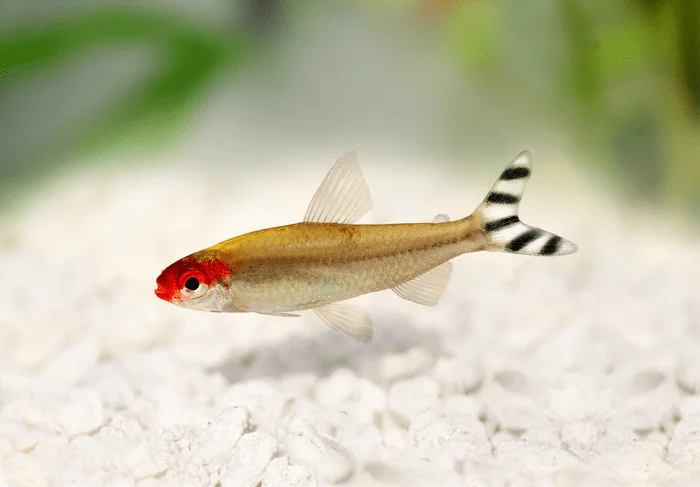
Introduction
If you’re considering Rummy Nose Tetra for your aquarium or seeking to improve their care, this comprehensive guide is perfect for aquarists at all levels. Known scientifically as Hemigrammus rhodostomus, Rummy Nose Tetra are cherished for their distinct red snouts and striking horizontal stripes. This guide will help you understand everything needed to ensure your Rummy Nose Tetra thrive in their aquatic home.
Understanding Rummy Nose Tetra
Origin and Characteristics
Originating from the Amazon River basin, encompassing regions in Brazil, Colombia, and Venezuela, Rummy Nose Tetras are a captivating sight in the home aquarium. These diminutive fish, usually not exceeding 2 inches (5 cm) in length, are distinguished by their vibrant red noses—a feature from which they derive their common name. This striking coloration extends from the nose through the front part of their body, contrasting beautifully with their silvery background.
Rummy Nose Tetras are further adorned with distinctive black and white tail striping, a characteristic that adds a unique and dynamic visual appeal to any aquarium setting. The precise, almost geometric pattern of their caudal fin, combined with their shimmering body, creates an eye-catching movement as they gracefully navigate the aquatic environment.
Beyond their visual allure, these tetras are known for their peaceful demeanor and strong schooling instincts. When kept in groups, they exhibit a mesmerizing, synchronized swimming behavior that not only enhances their own security but also contributes to a lively and cohesive aquarium community. This schooling nature, coupled with their striking appearance, makes Rummy Nose Tetras a favorite among aquarists looking to add a splash of color and vitality to their freshwater setups.
Adaptable and hardy, Rummy Nose Tetras thrive in well-maintained tanks that mimic their natural Amazonian habitats. They prefer slightly acidic to neutral pH levels and appreciate a tank adorned with plenty of plants and hiding spots. These conditions not only support their health and well-being but also encourage the display of their natural behaviors, ensuring that these vibrant fish remain a highlight in the aquatic hobby.
Behavior and Tank Mates
Rummy Nose Tetras are peaceful, schooling fish and do best in groups of six or more. They fit well in community tanks with other peaceful species. Their active swimming and non-aggressive nature make them popular among aquarium enthusiasts. Ideal tank mates for Rummy Nose Tetra include:
- Other Peaceful Tetras: Like Ember or Glowlight Tetras
- Dwarf Gouramis: Gentle and visually compatible.
- Small Barbs: Ensure they are not fin-nippers.
- Shrimp and Snails: Safe with these gentle tetra.
- Small Loaches: Compatible bottom dwellers.
It’s essential to select tank mates that are non-aggressive and won’t outcompete Rummy Nose Tetra for food. Consider water parameters, size, temperament, and dietary requirements for a harmonious aquarium. Introduce new fish carefully and monitor their interactions
Setting Up the Perfect Tank
Tank Size and Conditions
A 20-gallon tank or larger is recommended for a school of Rummy Nose Tetra but they will benefit from some more swimming room. These Tetra thrive in specific water conditions that mimic their natural habitat. Finally, maintaining ideal water parameters is the key to ensuring their health and well-being in a home aquarium. Here’s a breakdown of their ideal water conditions:
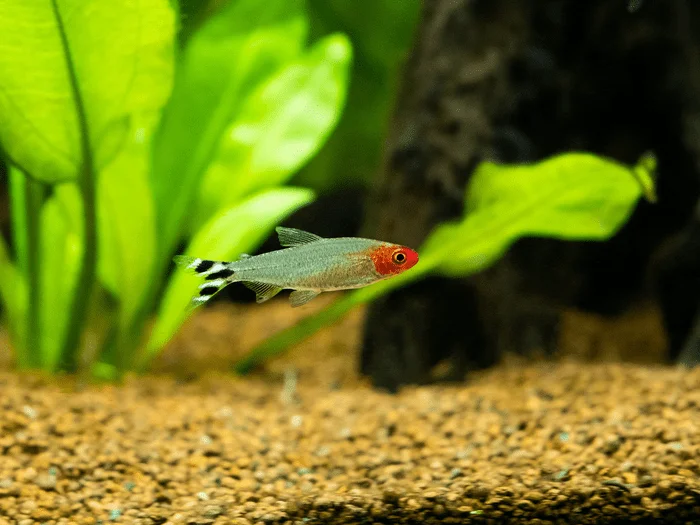
- Temperature: 75-80°F (24-27°C), suitable for their tropical nature.
- pH Level: 5.5 to 7.0, preferring slightly acidic to neutral water
- Water Hardness: 2-10 dGH, indicating a preference for soft water
- Water Quality: Like most fish, Rummy Nose Tetra require clean and well-oxygenated water. Regular water changes (about 25% per week) are recommended to maintain good water quality. It’s crucial to remove any chlorine or chloramine from tap water before adding it to the tank.
- Nitrate Levels: Keeping nitrate levels low is important, as high levels can be harmful. Aim to keep nitrates below 20 ppm.
- Ammonia and Nitrite Levels: Both ammonia and nitrite should always be at 0 ppm. Even small amounts of these can be toxic to fish.
It’s important to use a reliable aquarium test kit to regularly monitor these water parameters. Sudden changes in water conditions can stress or harm your fish, so any adjustments should be made gradually. Maintaining stable water conditions is key to the health and longevity of your Rummy Nose Tetra.
Lighting and Decor
- Moderate Lighting: Mimic their natural, slightly shaded habitat with moderate lighting.
- Day/Night Cycle: Maintain a regular cycle, typically around 10-12 hours of light per day.
- Plants: Dense vegetation, including tall and floating plants, to provide hiding spaces and a natural environment.
- Substrate: A dark-colored substrate can enhance the natural colors of the fish.
- Hiding Places: Include driftwood, rocks, and caves for shelter.
- Open Swimming Space: Ensure ample free-swimming space to accommodate their active swimming behavior.
Diet and Nutrition
Feeding Habits
Rummy Nose Tetra are omnivorous. Therefore, a balanced diet including high-quality flake foods, frozen or live brine shrimp, daphnia, and occasional vegetable supplements will keep them healthy.
Feeding Schedule
Feed them small amounts once or twice a day, being careful not to overfeed.
Health and Wellness
Breeding Tips
Breeding Rummy Nose Tetra can be a rewarding experience, but it requires a bit of preparation and understanding of their breeding behavior. Here are some tips to help you successfully breed Rummy Nose Tetra:
- Breeding Tank: Set up a separate tank with soft, slightly acidic water (pH around 6.0-6.5) and a temperature of about 77°F (25°C). Dim lighting and fine-leaved plants or spawning mops are recommended.
- Condition the Breeders: Feed them high-quality live or frozen foods to encourage spawning.
- Spawning Process: Introduce a well-conditioned pair or small group. Spawning usually occurs in the morning.
- Post-Spawning Care: Remove the adults post-spawning to prevent egg predation. The eggs typically hatch in about 6-7 days.
- Rearing Fry: Start with infusoria or liquid fry food, then to transition to micro worms or baby brine shrimp as they grow.
Remember, patience is key when breeding fish. It might take a few attempts before you see success. Keep a close eye on the water parameters and the health of both the adult fish and the fry to ensure a successful breeding experience. Good luck!
Common Health Concerns
Congo Tetra are susceptible to the same health issues as other tetras, such as ich and fungal infections. Proper tank management and water quality are crucial for their health. Learn more about taking care of your tank here.
Life Expectancy
With proper care, these tetras can live up to 5 -6 years. Regular monitoring and maintenance of the tank environment are key to their longevity
Frequently Asked Questions
Rummy Nose Tetras reach about 2 inches (5 cm) in length.
It’s best to keepRummy Nose Tetra in groups of at least 6 to encourage natural schooling behavior and reduce stress.
Rummy Nose Tetra are not aggressive and are well-suited for community tanks with other peaceful fish.
Rummy Nose Tetra Wrap Up
In conclusion, Rummy Nose Tetras serve as a stunning addition to freshwater aquariums, bringing with them a burst of dynamic movement and vivid coloration. By adhering to the principles outlined in this detailed care guide, you have the opportunity to cultivate a thriving aquatic environment that caters perfectly to the needs of these captivating fish. Their distinctive red noses and elegantly striped tails will not only become a focal point of your tank but also contribute to the overall vibrancy and life of your aquatic setup.
Creating and maintaining a stable, nurturing environment is paramount for the well-being of Rummy Nose Tetras. This includes ensuring the water quality is consistently high, with appropriate parameters—such as temperature, pH, and hardness—closely monitored and maintained. A well-planned tank, rich in plant life and with ample space for schooling, will mimic their natural Amazonian habitat, supporting their health and encouraging natural behaviors.
Moreover, fostering a community of Rummy Nose Tetras, by keeping them in groups, enhances their well-being and allows their schooling behavior to become a captivating display of natural beauty and harmony. Their peaceful nature makes them excellent inhabitants of community tanks, where they can coexist with other non-aggressive species, adding to the tank’s diversity without compromising the tranquility.
In nurturing these delightful creatures, you not only gain the joy of observing their unique aesthetics and behaviors but also the satisfaction of providing a harmonious and healthy environment for them to flourish. Remember, the success of your Rummy Nose Tetras is a reflection of the care and commitment you invest into their habitat. With the right conditions and dedicated care, your Rummy Nose Tetras will continue to enchant and animate your aquarium with their lively charm and striking beauty.
Share Your Tetra Experiences
Do you have any stories or tips about your Tetra tank? Share them in the comments below!
Help Others Discover This Guide
Navigate the Tetra in your tank with confidence. This guide is your pathway to creating a vibrant and healthy aquatic showcase. Enjoy the dazzling colors and lively nature of these unique fish!

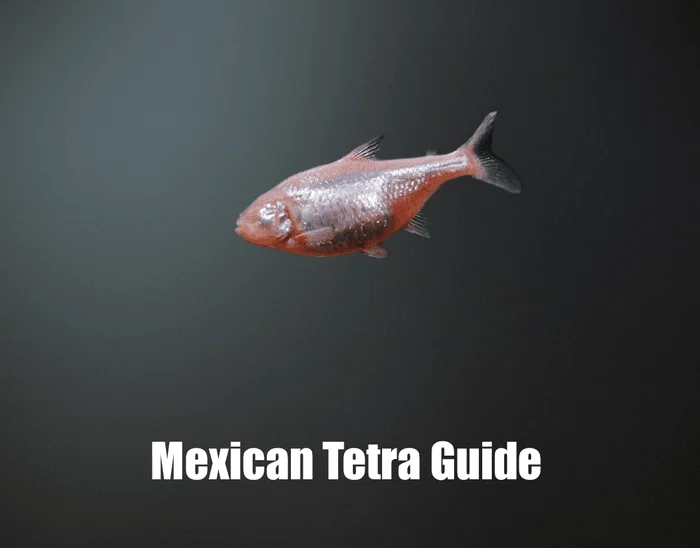
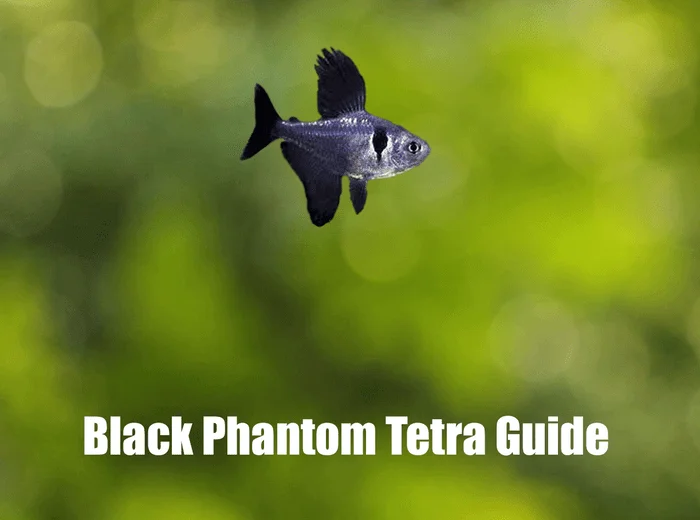
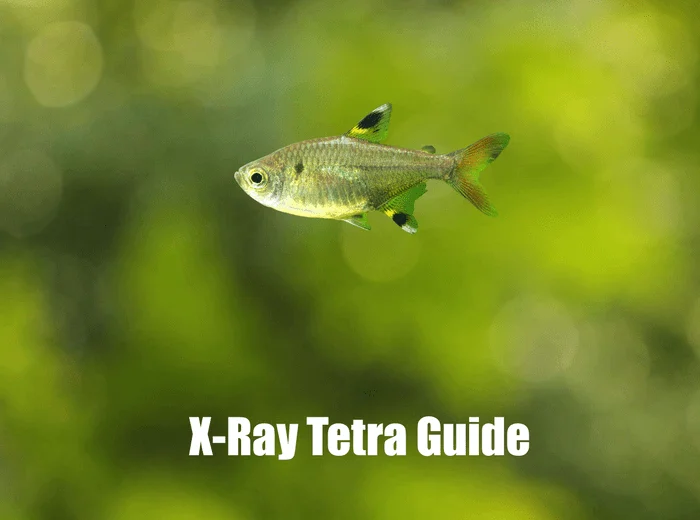
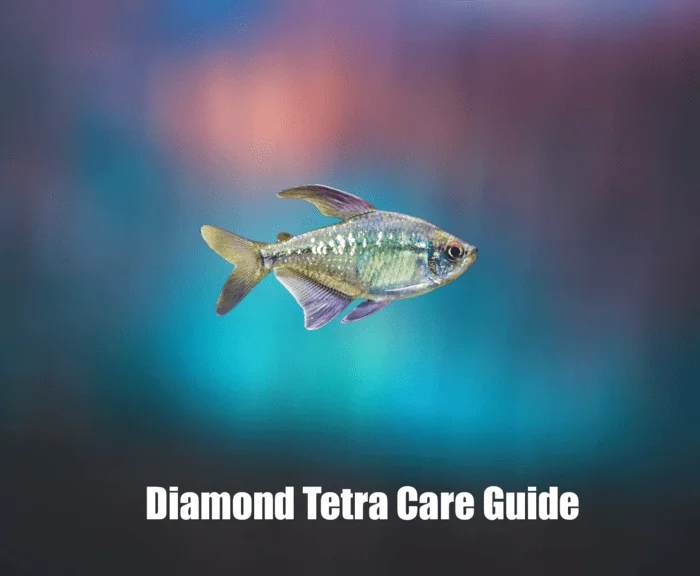
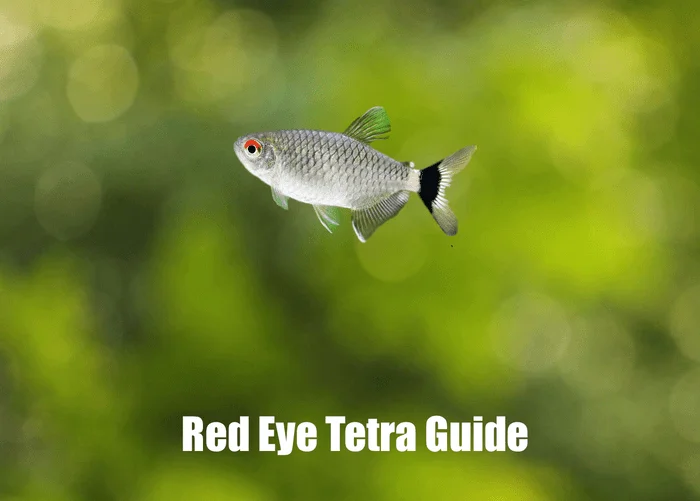
Pingback: The Ultimate Guide for Emperor Tetra
Pingback: The Ultimate Care Guide for Lemon Tetra
Pingback: The Ultimate Care Guide for Mexican Tetra
Pingback: The Ultimate Care Guide for Diamond Tetra
Pingback: The Ultimate Care Guide for Bloodfin Tetra
Pingback: The Ultimate Guide for White Skirt Tetra
Pingback: The Ultimate Care Guide for Red Eye Tetra
Pingback: The Ultimate Care Guide for Panda Tetra
Pingback: The Ultimate Care Guide For Colletti Tetra